Dealing with spider mites in your greenhouse requires vigilance and proactive measures. Start by inspecting the undersides of leaves for tiny yellow spots or fine webbing. Monitor conditions, keeping humidity above 60% and temperatures between 70°F and 80°F, as these factors can accelerate mite populations. Introduce predatory mites to control spider mite numbers biologically. Implement preventative practices, and if you're seeking effective chemical strategies, there's more you should explore to safeguard your plants.
Key Takeaways
- Regularly inspect the undersides of leaves with magnifying lenses to identify spider mites early.
- Maintain humidity above 60% and temperatures between 70°F and 80°F to deter spider mite reproduction.
- Introduce predatory mites like *Phytoseiulus persimilis* to control spider mite populations effectively.
- Tap leaves over white paper to monitor and count spider mites for timely interventions.
- Avoid using broad-spectrum pesticides to protect beneficial predators and maintain a balanced ecosystem.
Understanding Spider Mite Life Cycle
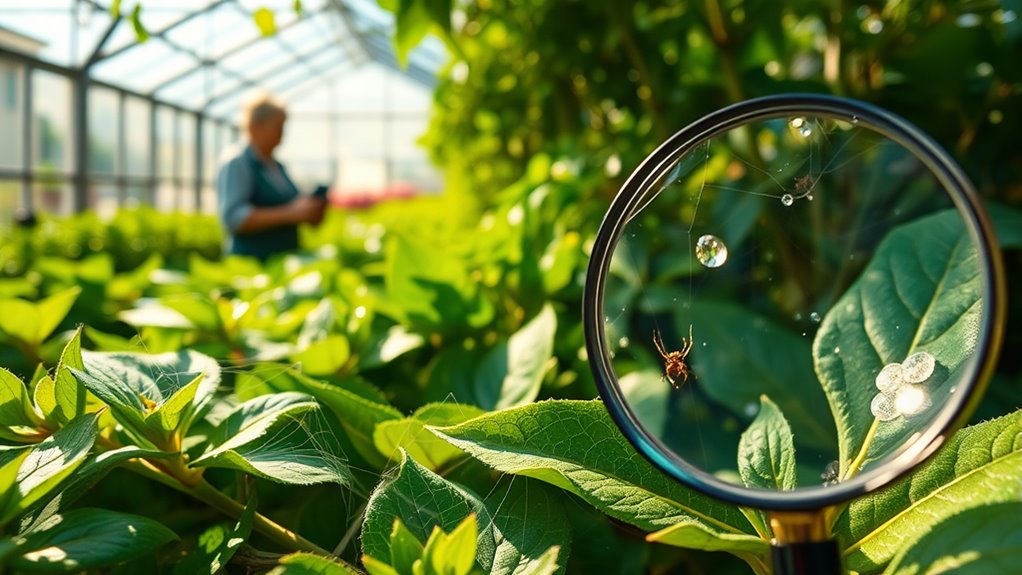
Understanding the spider mite life cycle is vital for effective management, especially since these pests can rapidly multiply under the right conditions.
The cycle begins with spherical, translucent eggs laid on the underside of leaves. These hatch into larvae with three pairs of legs, feeding for a few days before molting into the protonymph stage.
The life cycle starts with translucent eggs under leaves, hatching into larvae that quickly transition into their next stage.
There are two nymphal stages, each lasting 1-3 days, before they mature into adults, which have four pairs of legs. Females can lay 5-6 eggs daily, resulting in populations exploding within 7-10 days under ideal conditions.
Spider mites thrive in warm, dry environments, making understanding their life cycle essential for controlling their rapid growth and preventing infestations in your greenhouse.
Identifying Damage Caused by Spider Mites
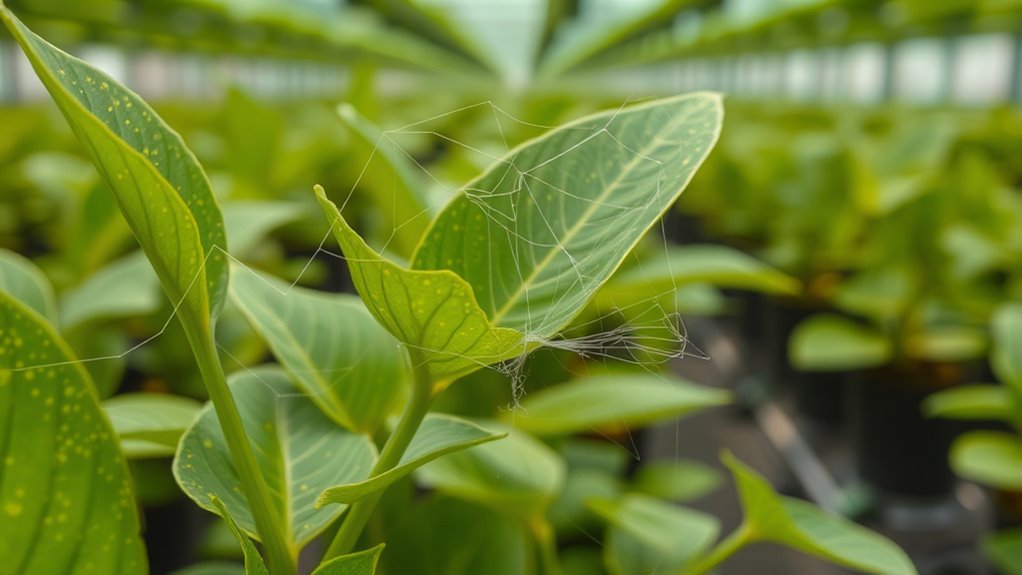
When you notice small yellow spots appearing on your plants' leaves, it's a clear sign that spider mites may be at work.
As the infestation progresses, these spots can spread, turning leaves entirely yellow and impairing photosynthesis.
Keep an eye out for fine webbing on the underside of leaves; this is another telltale sign of spider mites. You might also see tan or yellow specking due to their feeding damage.
Infestations can weaken your plants, affecting growth and nutrient absorption, which ultimately impacts harvest quality.
If you're growing tomatoes, cucumbers, or cut flowers, be especially vigilant, as these crops are common targets for spider mites.
Catching damage early can save your plants and protect your yields.
Scouting Techniques for Early Detection

To effectively manage spider mites, implementing scouting techniques for early detection is key.
Start by using magnifying lenses or hand lenses to inspect the undersides of leaves, where mites often hide. Regular scouting, at least once a week, is essential, especially during the early season.
Tap leaves over white paper to dislodge and count mites, or use smartphone cameras for magnification and documentation. If you find any, preserve samples in glass vials with denatured alcohol for further analysis.
Don't forget to check areas like behind benches and near fertilizer injection systems, as these can harbor spider mites.
Keeping track of your observations will help you monitor populations and react promptly to any infestations.
Importance of Environmental Conditions

Environmental conditions play an essential role in the management of spider mites in your greenhouse. They thrive in temperatures between 70°F and 80°F, accelerating their life cycle.
Low humidity is particularly favorable for two-spotted spider mites, helping them reproduce rapidly. Dusty environments can worsen infestations, while plants under water stress are more vulnerable to damage.
Low humidity and dusty conditions can intensify two-spotted spider mite infestations, leaving water-stressed plants especially vulnerable.
Keeping sufficient light levels supports spider mite activity, making your plants more susceptible. To combat this, maintain adequate soil moisture, control humidity, and regulate temperatures.
Reducing dust and providing shade during hot periods can greatly lower spider mite populations. By adjusting these environmental factors, you can create a less hospitable environment for spider mites and protect your crops.
Implementing Biological Control Methods
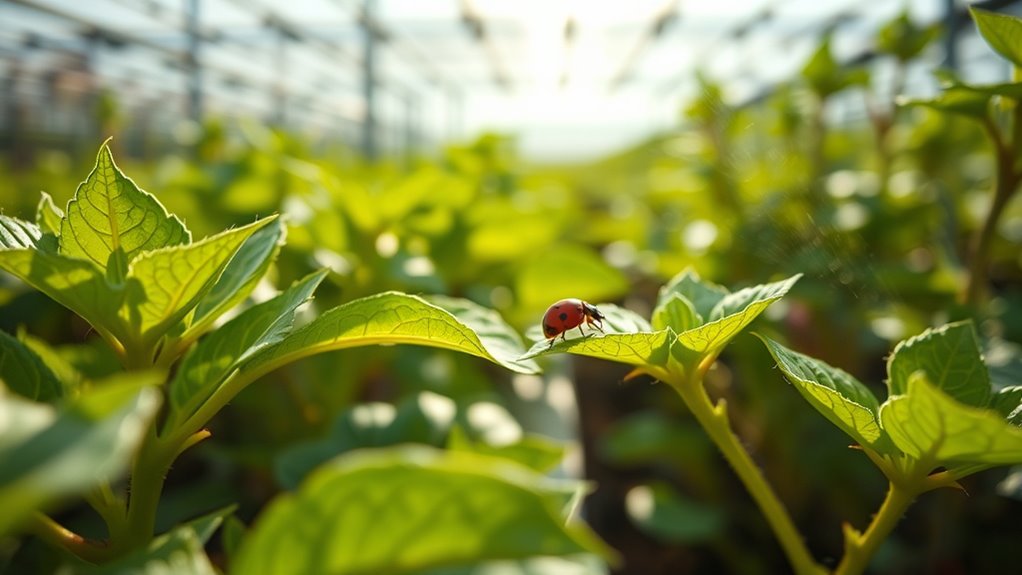
Implementing biological control methods can be a highly effective strategy for managing spider mite populations in your greenhouse. You can introduce predatory mites like *Phytoseiulus persimilis*, which can consume up to 20 spider mite eggs daily.
To maximize their effectiveness, release these predators at the first sign of spider mite activity and in areas with high densities. Regular monitoring is essential; use techniques like white paper sampling to detect early infestations.
Maintaining cooler temperatures and adequate humidity above 60% will support these beneficial mites. Avoid broad-spectrum pesticides to protect your control agents.
Effective Chemical Control Strategies
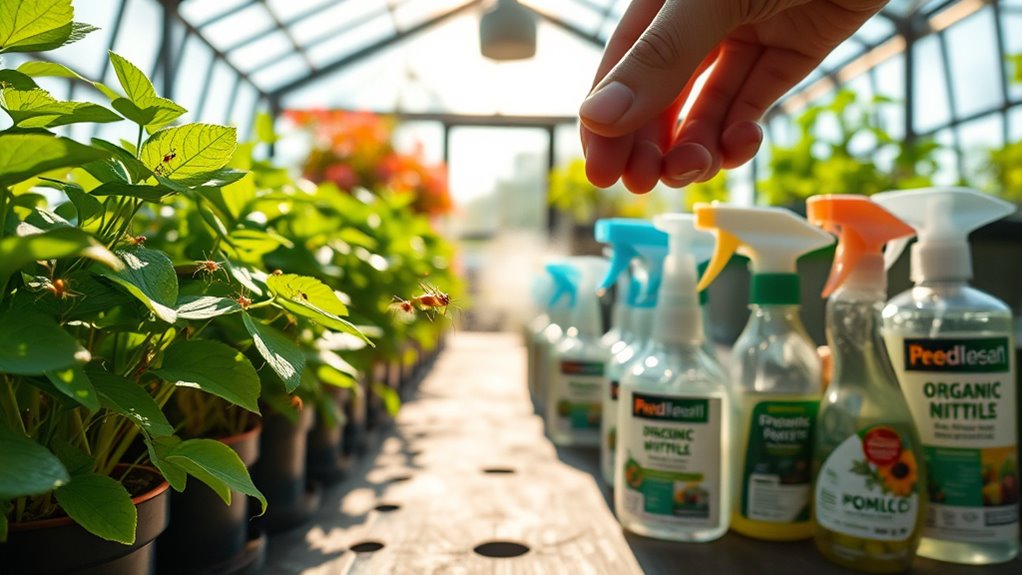
While biological control methods can effectively manage spider mites, you might find that integrating chemical control strategies becomes necessary for more immediate results.
Choose miticides specifically labeled for spider mite control, as regular insecticides often won't work. Be aware that some populations have developed resistance to common options like Avid and Floramite.
Timing is essential; apply pesticides during the early life stages for maximum effectiveness. Guarantee thorough coverage of both leaf surfaces, and consider high-volume applications if needed.
Rotate miticides to combat resistance and monitor their effectiveness regularly. Always follow label instructions to protect beneficial insects and minimize environmental impact.
Preventative Measures for Spider Mite Infestations

To effectively prevent spider mite infestations in your greenhouse, focus on maintaining ideal environmental conditions and promoting plant health.
Keep temperatures below 68°F to slow their growth, and increase humidity to deter reproduction. Guarantee proper ventilation to prevent mite invasion and consider shading to reduce heat stress on your plants.
Water your plants adequately and avoid over-fertilizing to prevent lush growth that attracts mites. Promote biodiversity to encourage natural predators, and quarantine new plants to avoid introducing pests.
Regularly clean your greenhouse to eliminate overwintering mites and sanitize tools to prevent spread.
Monitoring and Evaluating Control Measures
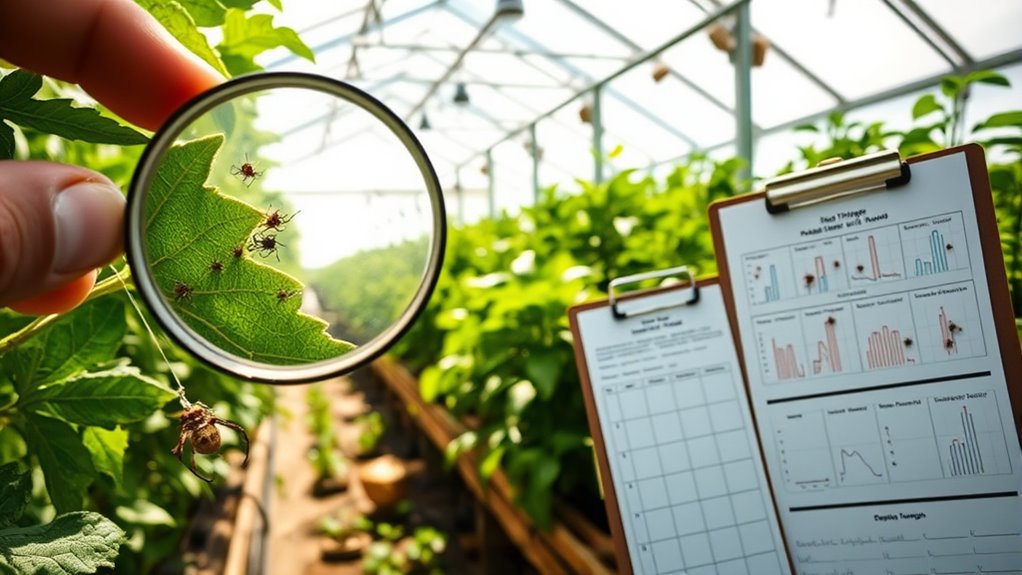
Effectively monitoring and evaluating control measures for spider mites is essential in managing infestations before they escalate.
Start by conducting regular visual inspections, particularly on the undersides of leaves, to catch any signs of mites or webbing. Utilize early detection methods like satellite monitoring systems to identify plant stress that may indicate spider mite activity.
Given their rapid population growth, you'll want to implement interventions quickly. Evaluate the effectiveness of your control measures, whether they're chemical, biological, or cultural.
Rotate miticides to prevent resistance and consider introducing predatory mites for biological control. Keep detailed records of your strategies and outcomes to refine your approach continuously.
Regular monitoring will guarantee you're on top of any potential outbreaks.
Best Practices for Worker Hygiene and Plant Care

Maintaining high standards of worker hygiene and plant care is essential in preventing spider mite infestations. You should wear protective clothing to avoid carrying mites and conduct daily scouting in infested areas during the evening to minimize spread.
Keep all equipment clean and guarantee good personal hygiene to further reduce mite transfer.
Regularly inspect plants weekly, focusing on the undersides of leaves with a hand lens to spot mites. Dislodge them gently onto white paper for easier identification.
Avoid over-fertilization and manage water levels to prevent stress, which attracts mites. Control weeds around the greenhouse and promptly remove any infested plants.
These practices create a healthier environment for both workers and plants, ultimately reducing the risk of spider mite problems.
Frequently Asked Questions
How Can I Tell if My Plants Are Infected With Spider Mites?
To tell if your plants are infected with spider mites, look for fine, silken webs between leaves and stems.
Check for yellow or white spots on leaves, which indicate feeding damage, and watch for a dusty appearance.
If your plants show stunted growth or leaves aren't unfurling, that's another sign.
Regularly inspect your plants, especially when temperatures rise, as spider mites thrive in warmer conditions.
Early detection is key to managing infestations.
What Are the Most Effective Natural Predators for Spider Mites?
For effective spider mite management, consider enchanting creatures like predatory mites, gall midges, and predatory beetles.
Phytoseiulus persimilis and Neoseiulus californicus swiftly seek out spider mites, while gall midges actively attack larvae and clear webs.
Don't forget the Spider Mite Destroyer beetle, which thrives in high mite populations.
Each of these natural predators offers a powerful, pesticide-free approach to pest control, helping you maintain a healthy ecosystem in your garden.
Can Spider Mites Affect Indoor Plants as Well?
Yes, spider mites can definitely affect indoor plants. They thrive on various species, particularly those that prefer warm, dry conditions.
If you notice yellowing leaves or fine webbing, it's likely your plants are infested. Regular inspections and maintaining humidity levels can help prevent infestations.
If you spot them, act quickly to protect your plants, using methods like insecticidal soap or introducing predatory mites to manage the problem effectively.
How Often Should I Inspect My Greenhouse for Spider Mites?
An ounce of prevention is worth a pound of cure.
You should inspect your greenhouse weekly, starting from the transplant stage until harvest. Make sure to check for early signs of infestation, like light specking on leaves, using a magnifying lens for a thorough look.
If temperatures rise or you've had past issues, increase your monitoring frequency. Regular inspections will help you catch any problems before they escalate, saving you time and resources.
What Temperature and Humidity Levels Discourage Spider Mite Infestations?
To discourage spider mite infestations, keep temperatures below 68°F and increase relative humidity above 50%.
Cooler temperatures slow their development, while higher humidity levels make it less favorable for them to thrive.
Regularly monitor your environment and adjust conditions as needed.
Conclusion
In the battle against spider mites, think of your greenhouse as a garden of resilience. By understanding their life cycle and spotting early signs of trouble, you're planting seeds of prevention. Embrace biological controls like friendly predators, and wield chemicals wisely when necessary. Just as a gardener nurtures their plants, your diligence in monitoring and maintaining hygiene guarantees a thriving environment. Remember, a vigilant caretaker can transform the tiniest threats into mere shadows among the vibrant blooms.









